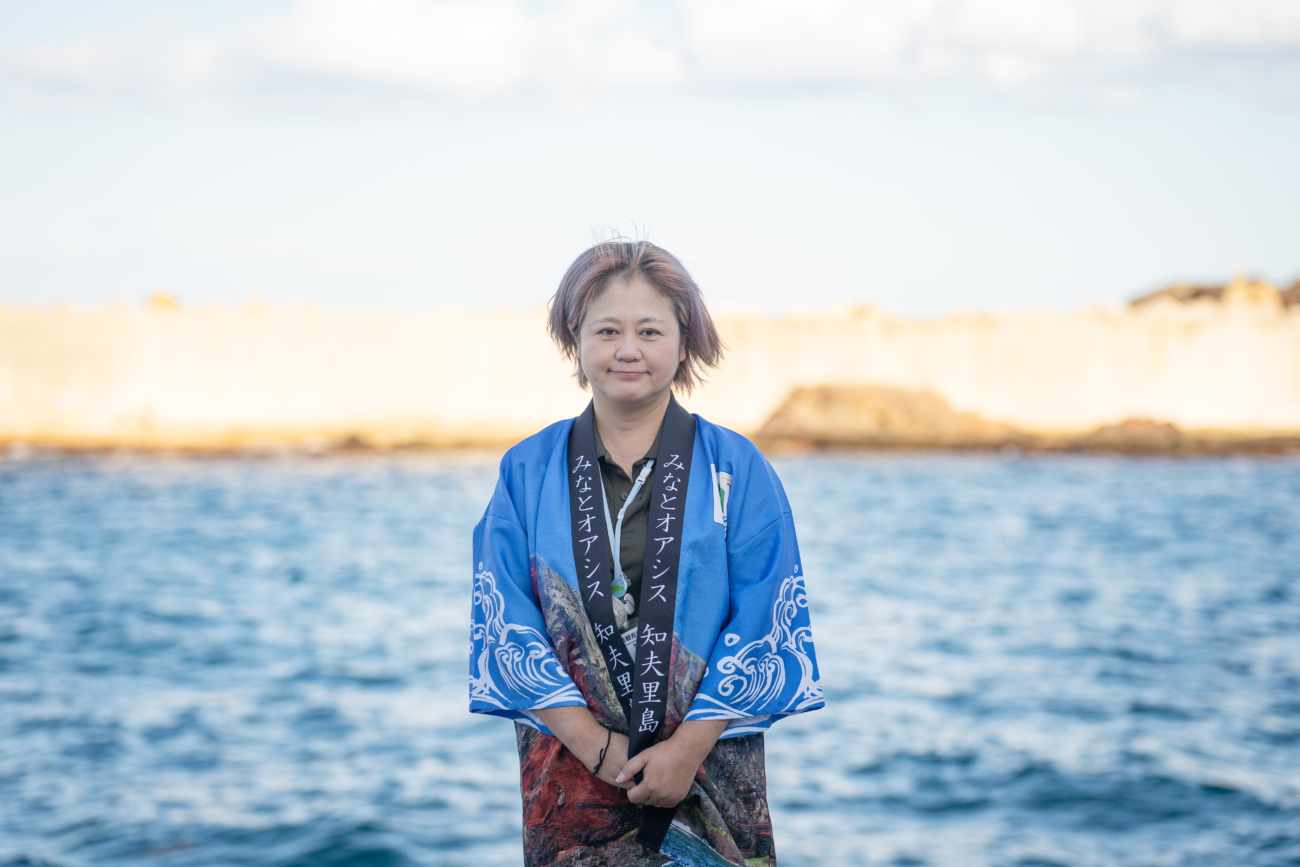A True Local Tour Guide Who Knows Chiburijima Island Inside and Out
The “Red Cliff of Chibu” or Sekiheki in Japanese, is a cliff that stretches for up to 3 kilometres and ranges from 50 to 200 meters in height. As the name suggests, the cliff is a “red wall” with vivid colors, which is a rare sight even around the world.
Chiburijima Island, the smallest inhabited island of the Oki Islands, you can enjoy this spectacular scenery, worthy of its status as a geopark.
Ms. Takegawa was our guide for this visit. She was born and raised on Chiburijima Island, After high school she left the Island to study Art in Kyoto, from there she started work in a Kimono shop, working on traditional crafts such as gold leaf processing and shibori patterns (traditional fabric dyeing). Furthermore, She had a desire to live abroad which brought her to France, here she attended a language school. After her time in France she returned to Chiburijima island where she currently resides and works as an island guide while also working for the tourism association. Surprisingly, both guides on this small island, both with unique backgrounds, have ties to France.
Mt. Akahage, where you can enjoy a 360-degree panorama of Chiburijima Island, and Sekiheki (Red Cliff) are both famous sightseeing spots on the island. Since the weather was excellent and the sea was calm on the day of the interview, we went on a cruise on the Sekiheki (Red Cliff) Sightseeing Boat. The cruise departs from Kurii Port, and it takes about an hour to go around the island. The best part is being able to see the whole of Sekiheki (Red Cliff) up close from the boat, which is a sight that cannot be enjoyed from land. Another fun part is being introduced to hidden spots that are not listed in the brochures and learning about the interesting stories related to these spots on board.
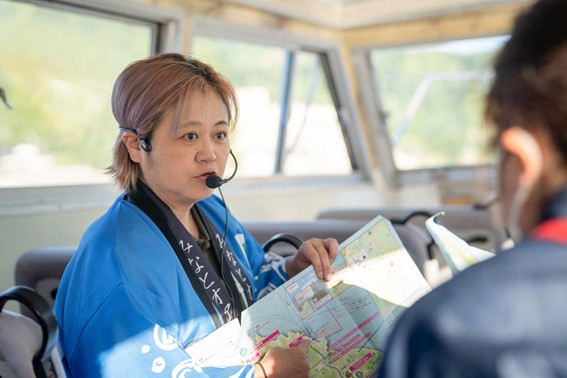
Putting on the microphone, Ms. Takegawa took us on a journey.
“Chiburijima Island is famous for its ‘red wall’, but there is also a ‘white wall’. which is a trachyte cliff. Perhaps as a reference to the island’s symbol, Red Cliff, this is also called White Cliff. in contrast to Sekiheki (Red Cliff) it is made of a white volcanic rock, but the geometric patterns formed by the deposition of iron-containing minerals and the marble-like veins create a beautiful rock face.”
Rock walls that would be easily overlooked without a tour guide are transformed into new tourist attractions through the guide’s detailed explanations. As you would expect from a geopark, precious geological layers and unique formations are revealed on both sides as the sightseeing boat continues its journey. Each of the layers is engraved with stories of nature, formed over tens and thousands of years. The tour guide’s explanations help us understand the background of each layer.
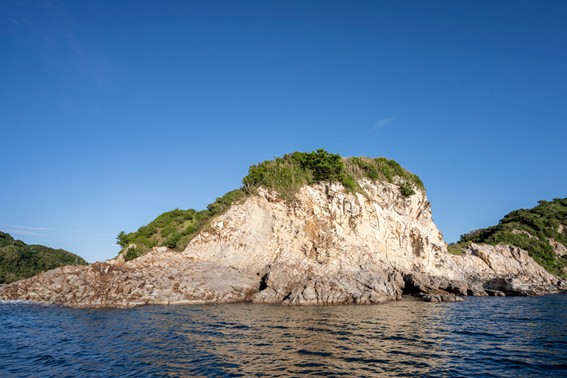
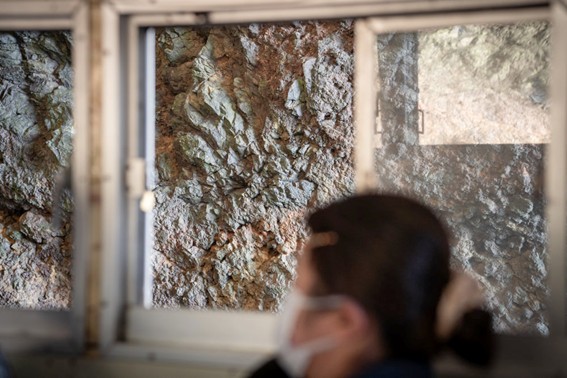 ↑ As the sightseeing boat enters a sea cave, the inside, carved by the rough waves, is revealed.
↑ As the sightseeing boat enters a sea cave, the inside, carved by the rough waves, is revealed.
The most common way to get to Chiburijima Island is by large ferries or smaller inter-island ferries. But if you want a different experience and insight into Chiburijima, the sightseeing cruise is highly recommended. The sightseeing cruise will bring you up close to the impressive rock formations, and the mere sensation of being rocked by the waves is interesting.
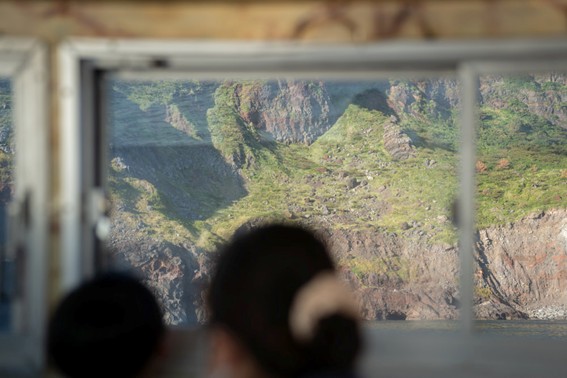
“This is the site of a landslide that occurred in the past. In 1978, when I was in fourth grade of primary school, heavy rain caused the river to overflow, causing a disaster so severe that houses were washed away. As a result of that deluge of rain, a landslide occurred in this entire area.”
While most island tour guides are from other locations, Ms. Takegawa was born and raised on Chiburijima Island. Other than explanations about the island’s geology, she stands out as a storyteller who weaves the stories of the island into the tour, such as daily happenings, local history and events. Her storytelling gives visitors a glimpse into the real life and history of the island that only those who were born and raised there know.
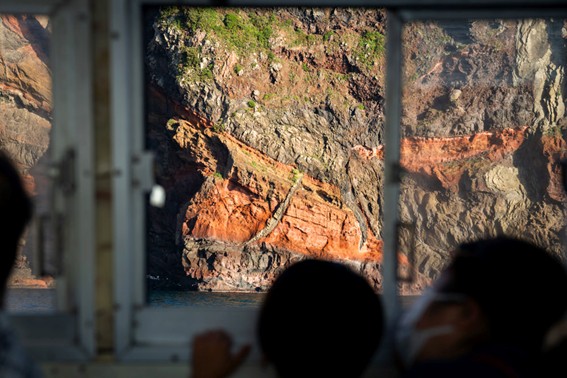
As the sightseeing boat approaches Red Cliff, the climax of the cruise, the vivid colors of the red rocks become more prominent. After the sightseeing boat arrived in front of the Red Cliff, the captain turned off the engine, and passengers moved to the deck outside. Ms. Takegawa then gave a detailed explanation of the magnificent beauty of the natural formation.
“Stretching for about 3 kilometres, Red Cliff is characterized by its vivid colors of red, yellow and brown. This phenomenon occurs when magma from a volcanic eruption, still at high temperature, comes into contact with the air, oxidizing the iron and turning the majority of it red. The whitish-grey streak running vertically down the red rock is the vent where magma once rose. Beyond that was a crater, from which magma erupted. In other words, we are now looking at a cross-section of a spectacular event that has taken place inside the Earth.”
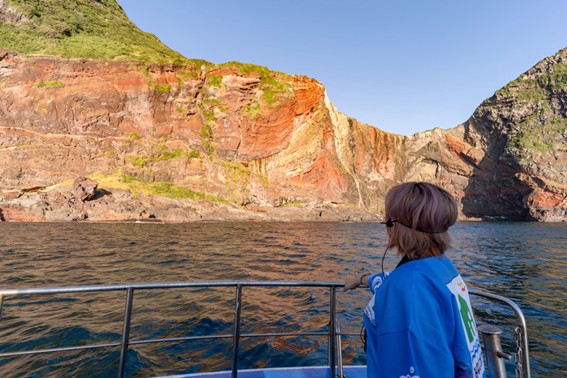
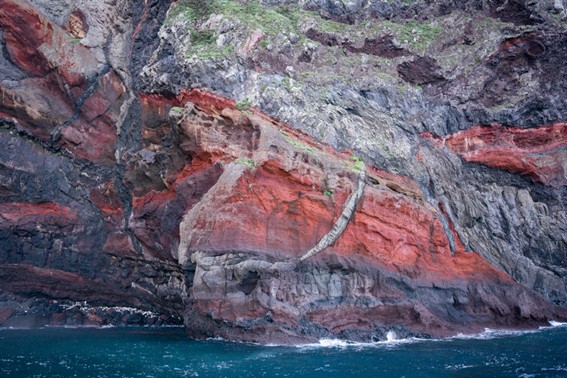
Many visitors made reservations for the Red Cliff Sightseeing Boat at sunset hours. Illuminated by the setting sun, the cliff is bathed in a soft orange hue, creating a dramatic and breathtakingly beautiful sight. Just imagining the scene is sufficient to have one mesmerised.
Unfortunately, we weren’t able to witness this beautiful moment in person this time. But Ms. Takegawa showed us some of her photos. In order to see the spectacle, a few conditions must be met: when the sea is calm, and only a few clouds on the horizon. Depending on the timing, you might not be able to see it, but if you come and visit Chiburijima Island, we highly recommend that you give it a try.
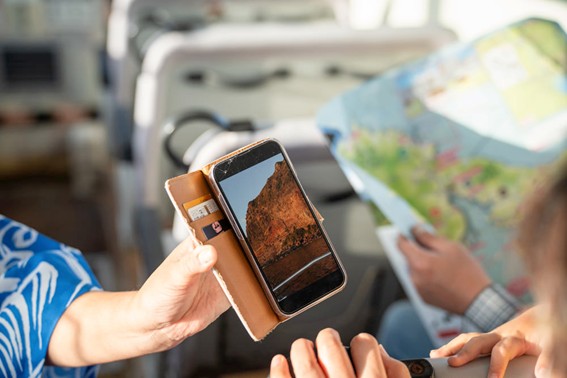
Ms. Takegawa returned to her hometown 22 years ago.
“When I was a child, I thought this was ‘a place with nothing’. It was quiet, and I often felt lonely, so deep in my heart I always had the thought that I would ‘definitely leave this island’. while, you end up getting used to it.”
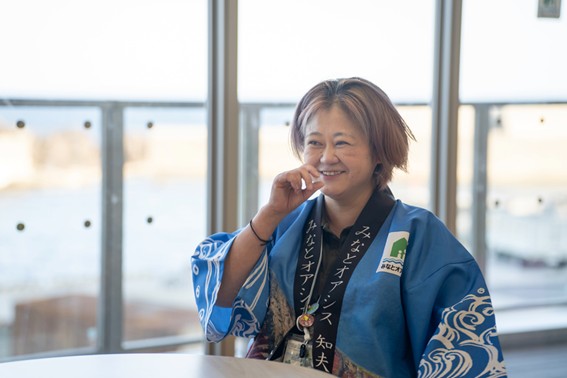
Feeling dissatisfied with her daily life, Ms. Takegawa traveled to Paris, France, a place she had longed to visit. She was excited about the new challenges brought by art and learning the language, as well as life in a foreign country. However, following the passing of her mother, she decided to return to her hometown. This island, her hometown that she left behind for a long time, was supposed to be a place where she had previously felt there was “nothing”. Yet, Ms. Takegawa felt a strange sense of relief; just like a ship returning quietly to her home port after a long voyage. It was also the first time, after living in the city, that she understood the value of her hometown.
Perhaps, the “loneliness” that she previously felt was in fact the luxury of “tranquility”. With this in mind, after running her late mother’s guesthouse for several years, she started working for the tourism association and began her career as a tour guide.
“There were hardly any tour guides on the island. So I thought that unless someone took up the position, the charm of the island would not be conveyed, so I became a tour guide. At the time, I was the only one, and sometimes I had to speak to international visitors in French and English. Looking back now, I think I did a really good job.”
Now, David, the French tour guide of the team, is in charge of receiving visitors from overseas.
“Thanks to David, we now share the role and can conduct tours more efficiently,” says Ms. Takegawa with a smile.
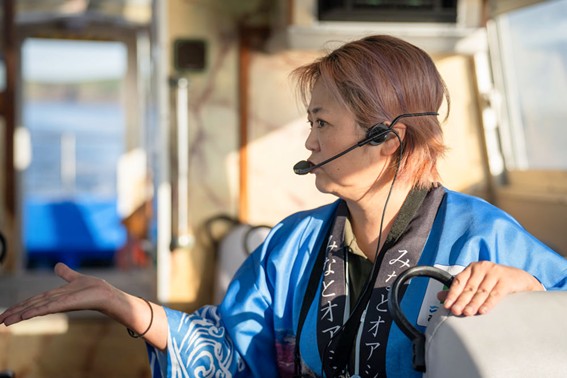
“When I show my guests around as a guide, I don’t just take them around the famous spots on the island. I also talk about local folklore and share my firsthand accounts. For example, how the fishermen used to catch fish, the problems that the island is now facing, stories that have been passed down by generations, and the culture that has been cherished here. By knowing more about the background, I hope our visitors will be able to feel a deeper connection with the island. Also, as a geopark, there are many to be discovered and enjoyed. I want to add more to what I can share or talk about in the future.”
Ms. Takegawa has not only deepened her knowledge of the geopark. She has also built her unique style by exploring what visitors are looking for, and what kinds of things, such as sightseeing spots and activities, would be most appealing. Ms. Takegawa picked up the role of being a tour guide on Chiburijima Island almost from scratch; other than many trials and errors, there were a lot of hardships along the way.
But Ms. Takegawa is not only focusing on her own work; she also believes it is necessary to train the next generation of tour guides.
“There are only a few tour guides. I want to be able to provide support, so more people can join the field. This year the geopark organized a training course, and we are expecting two or three new tour guides to join the field. I hope to be able to pass on the charm of the island and impart knowledge to the next generation.”
Behind these efforts lies the practical issue of a shortage of torchbearers for the tourism industry. Recently, in addition to sightseeing tour guides, marine activities such as SUP (stand-up paddleboarding) and sea kayaking tours have become popular, and there seems to be a shortage of specialists in this field.
“More and more guests are coming to enjoy hands-on activities rather than just visiting sightseeing spots. To meet their expectations, there is an urgent need for activity tour guides in that field,” Ms. Takegawa points out.
Playing the roles of a staff member of the tourism association and a tour guide, her sights are on the future of the island.
The Mesmerising Sunset Sea Overlooking Kanjima Island
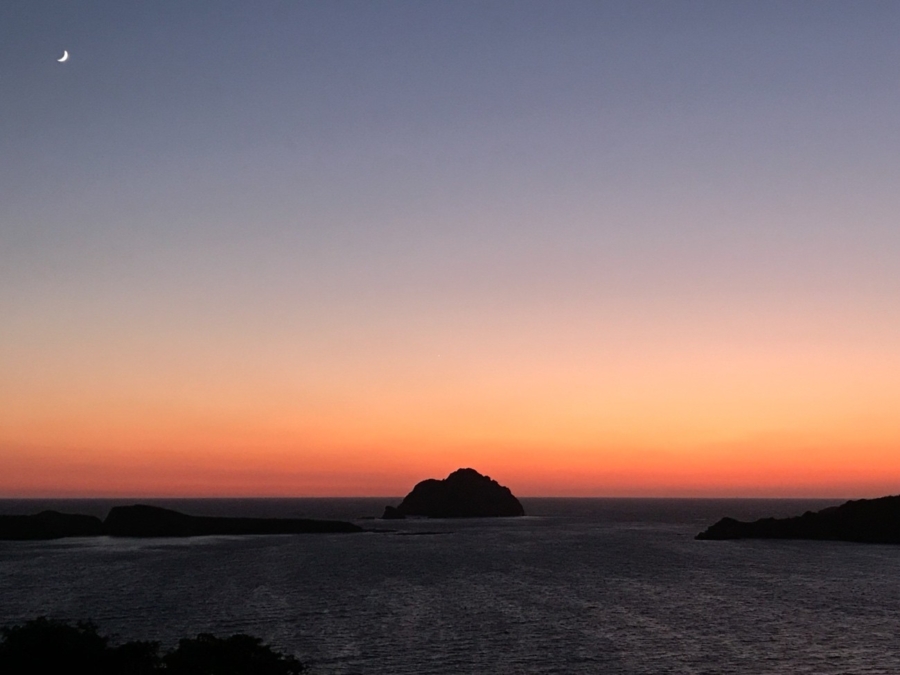
Head east on Prefectural Route 332 Chiburijima Line, pass Shijumagari Pass, which is on the border between Tataku area and Usuge area, and then go down the road for about 100 – 200m towards Usuge area. You will find a quiet, unnamed place. The view there gives a sense of openness; its beauty captivates you no matter how many times you visit.
The autumn sunsets are especially beautiful. I love the way the horizon turns crimson red just after the sun sets, and then the color of the sky gradually changes towards the dark color of the night sky. For me, it is a moment where I feel connected with the universe, and there is an indescribable feeling.

